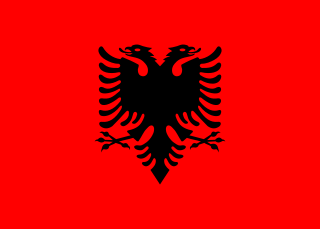
Albania, officially the Republic of Albania, is a country in Southeast Europe. It is in the Balkans, on the Adriatic and Ionian Seas within the Mediterranean Sea, and shares land borders with Montenegro to the northwest, Kosovo to the northeast, North Macedonia to the east and Greece to the south. Spanning an area of 28,748 km2 (11,100 sq mi), it has a varied range of climatic, geological, hydrological and morphological conditions. Albania's landscapes range from rugged snow-capped mountains in the Albanian Alps and the Korab, Skanderbeg, Pindus and Ceraunian Mountains, to fertile lowland plains extending from the Adriatic and Ionian seacoasts. Tirana is the capital and largest city in the country, followed by Durrës, Vlorë, and Shkodër.

Albanian culture or the culture of Albanians is a term that embodies the artistic, culinary, literary, musical, political and social elements that are representative of ethnic Albanians, which implies not just Albanians of the country of Albania but also Albanians of Kosovo, North Macedonia and Montenegro, where ethnic Albanians are a native population. Albanian culture has been considerably shaped by the geography and history of Albania, Kosovo, parts of Montenegro, parts of North Macedonia, and parts of Northern Greece, traditional homeland of Albanians. It grew from that of the Paleo-Balkan cultures, including Proto-Albanian, Illyrian, Thracian, Dacian, with their pagan beliefs and specific way of life in the wooded areas of far Southern Europe. Albanian culture has also been influenced by the Ancient Greeks, Romans, Byzantines and Ottomans.

The music of Albania is associated with the country of Albania and Albanian communities. Music has a long tradition in the country and is known for its regional diversity, from the Ghegs in the North to the Tosks in the South. It is an integral part of the national identity, strongly influenced by the country's long and turbulent history, which forced Albanians to protect their culture from their overlords by living in rural and remote mountains.

Toriyama Sekien, real name Sano Toyofusa, was a scholar, kyōka poet, and ukiyo-e artist of Japanese folklore. Born to a family of high-ranking servants to the Tokugawa shogunate, he was trained by Kanō school artists Kanō Gyokuen and Kanō Chikanobu, although he was never officially recognized as a Kanō school painter.
Albanian literature stretches back to the Middle Ages and comprises those literary texts and works written in Albanian. It may also refer to literature written by Albanians in Albania, Kosovo and the Albanian diaspora particularly in Italy. Albanian occupies an independent branch within the Indo-European family and does not have any other closely related language. The origin of Albanian is not entirely known, but it may be a successor of the ancient Illyrian language.

Eric Pratt Hamp was an American linguist widely respected as a leading authority on Indo-European linguistics, with particular interests in Celtic languages and Albanian. Unlike many Indo-Europeanists, who work entirely on the basis of written materials, he conducted extensive fieldwork on lesser-known Indo-European languages and dialects, such as Albanian, Arbëresh and Arvanitika; Breton; Welsh; Irish; Resian and Scots Gaelic.

Albanian Americans are Americans of full or partial Albanian ancestry and heritage in the United States. They trace their ancestry to the territories with a large Albanian population in the Balkans and southern Europe, including Albania, Italy, Kosovo, North Macedonia and Montenegro. They are adherents of different religions and are predominantly Muslims and Christians, while some are irreligious.

Sami bey Frashëri or Şemseddin Sâmi was an Ottoman Albanian writer, philosopher, playwright and a prominent figure of the Rilindja Kombëtare, the National Renaissance movement of Albania, together with his two brothers Abdyl and Naim. He also supported Turkish nationalism against its Ottoman counterpart, along with secularism against theocracy.
Vath Koreshi (1936–2006) was one of the most renowned Albanian novelists and screen writers. He is perhaps best known for writing a series of romans and novels such as “The two Saturdays of Susana" (1971), “The Hajji of Frakulla" and “The marriage of Sako" (1980),“Requiem for a woman" (1995), "The wulf and the star" (1996), “A woman in yellow in Buddha Forest" (2003) etc., but also for writing scripts to the movies "Gjeneral Gramafoni" (1978); "Rrugë të Bardha" (1974). "Balada e Kurbinit" (1990) etc.

The Encyclopedia of Yugoslavia or Yugoslavika was the national encyclopedia of the Socialist Federal Republic of Yugoslavia. Published under the auspices of the Yugoslav Lexicographical Institute in Zagreb and overseen by Miroslav Krleža, it is a prominent source and comprehensive reference work about Yugoslavia and related topics.
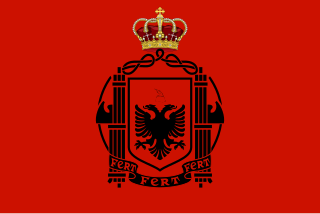
The Italian protectorate of Albania, also known as Italian Albania, the Kingdom of Albania or Greater Albania, existed as a puppet state and protectorate of Fascist Italy. It was practically a union between Italy and Albania, officially led by Italian King Victor Emmanuel III and his government: Albania was led by Italian governors, after being militarily occupied by Italy, from 1939 until 1943. During this time, Albania ceased to exist as an independent country and became an autonomous part of the Italian Empire. Officials intended to make Albania part of a Greater Italy by assimilating Albanians as Italians and colonizing Albania with Italian settlers from the Italian Peninsula to transform it gradually into an Italian land.
The traditional Albanian clothing includes more than 500 different varieties of clothing in all Albania and the Albanian-speaking territories and communities. Albania's recorded history of clothing goes back to classical times. It is one of the factors that has differentiated this nation from other European countries, dating back to the Illyrian period.

The Corfu Channel incident consists of three separate events involving Royal Navy ships in the Channel of Corfu which took place in 1946, and it is considered an early episode of the Cold War. During the first incident, Royal Navy ships came under fire from Albanian fortifications. The second incident involved Royal Navy ships striking mines; and the third occurred when the Royal Navy conducted mine-clearing operations in the Corfu Channel, but in Albanian territorial waters, and Albania complained about them to the United Nations.
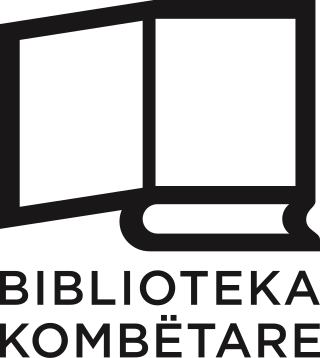
The National Library of Albania is Albania's national library headquartered in the country's capital, Tirana. It was founded in 1920 and inaugurated on December 10, 1922.
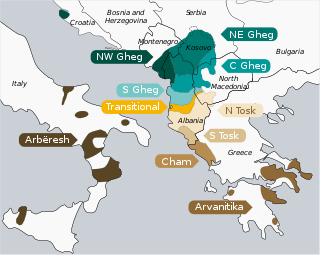
Albanian is an Indo-European language and the only surviving representative of the Albanoid branch, which belongs to the Paleo-Balkan group. Standard Albanian is the official language of Albania and Kosovo, and a co-official language in North Macedonia and Montenegro, as well as a recognized minority language of Italy, Croatia, Romania and Serbia. It is also spoken in Greece and by the Albanian diaspora, which is generally concentrated in the Americas, Europe and Oceania. Albanian is estimated to have as many as 7.5 million native speakers.

Spiro Risto Dine (1846–1922) was an Albanian rilindas, writer and playwright. His most known work "Waves of the Sea" was at the time of its publication the longest book printed in Albanian.

Albania was an Albanian periodical published by Faik Konica, one of the most important figures of Albanian culture in the early decades of the twentieth century. Albania was published from 1896-7 to 1910 and is widely regarded as the most important Albanian periodical in the beginning of the 20th century and one of the most important Albanian periodicals to have existed until the end of World War II.

Andrea Shundi was an Albanian-American agronomist. His academic research and publications focused mainly on the forage systems as a source feeding of the livestock, on viticulture and viniculture, and also on the history of the Albanian agriculture.
Drago Siliqi was an Albanian poet, literary critic, and publisher. At the age of 14 he became a scout and then a partisan of the National Liberation Movement. He published his first collection of poetry, and then pursued university studies at the Maxim Gorky Literature Institute in Moscow.
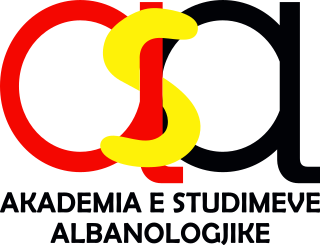
The Academy of Albanological Studies (AAS) is the main institution of albanology in Albania.















